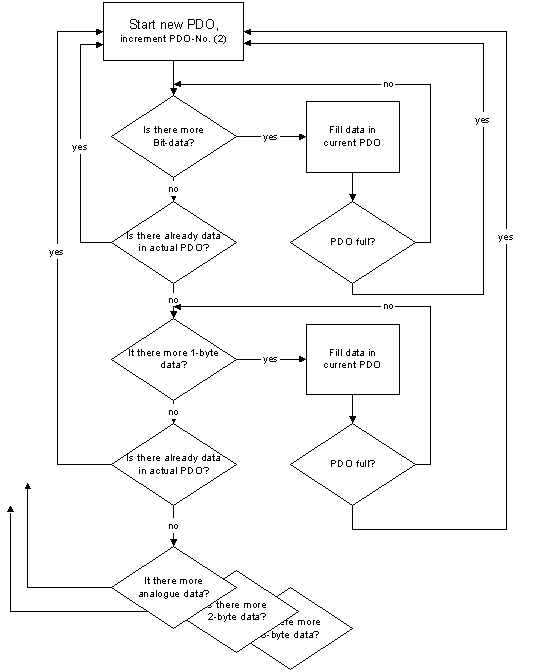Automatic PDO Mapping
BK51x0, IL23x0-B510
PDO1 and PDO2 are occupied, as described, with digital and analog process data. For each additional PDO the CANopen node acts in accordance with the following procedure, and puts process data into the PDOs in the following sequence:
1. Digital I/Os (if more than 64 are present)
2. 1-bytes special terminals
3. Analog I/Os
4. 2-bytes special terminals
5. 3-bytes special terminals
6. ...10. 8-bytes special terminals
Data types are not mixed, and a new PDO is taken for each new data type. for example
The procedure is illustrated in the flow diagram below.

Example
Example
A BK5120 CANopen coupler has altogether 78 digital inputs and 48 digital outputs, 6 analog inputs and 10 analog outputs, 1 SSI transducer interface (by default 2 x 2 bytes input), 1 serial interface (by default 2 x 2 bytes each input + output) and an incremental encoder interface (6 bytes each input + output):
PDO | Data contents (mapping) | PDO | Data contents (mapping) |
|---|---|---|---|
RxPDO1 | digital outputs 1..48 | TxPDO1 | digital inputs 1..64 |
RxPDO2 | analog outputs 1.0.4 | TxPDO2 | analog inputs 1..4 |
RxPDO3 | analog outputs 5..8 | TxPDO3 | digital inputs 65...78 |
RxPDO4 | analog outputs 9+10 | TxPDO4 | analog inputs 5+6 |
RxPDO5 | 2x2 serial interface | TxPDO5 | 2x2 SSI+2x2 serial |
RxPDO6 | 6 bytes encoder output | TxPDO6 | 6 bytes encoder input |